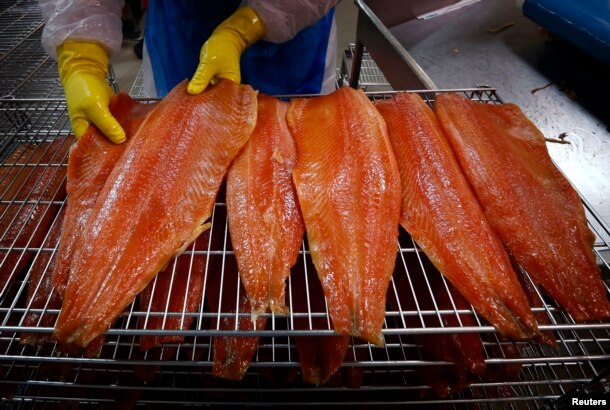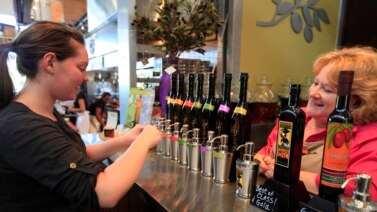
From VOA Learning English, this is the Health & Lifestyle report.
There is an old saying: “You are what you eat.”
When you eat the right foods, you feel better physically. But what you eat can also make you feel better emotionally and mentally.
American Leslie Korn is a mental health expert. She has been treating people for trauma and depression for more than 40 years.

Korn noticed that some of the foods her patients were eating seemed to affect their mental health. She noted that eating foods like dark chocolate, sweet potatoes, eggs and cherries seemed to lower pain levels and ease signs of depression in the patients.
She likens the human body to an automobile - a car that needs the right fuel to run.
“I think about our body in some ways like a car engine. We need to give it the right fuel. And each of us have a need for a particular combination of proteins, and carbohydrates and fats.”
Leslie Korn was so sure of what she observed in her patients that she wrote about it. Her book is called “The Good Mood Kitchen: Simple Recipes and Nutrition Tips for Emotional Balance.” In it, she explains the importance of specific foods -- like fats.
“The brain is made up of fat. It’s made up of chemicals that talk to each other and that are lubricated by the fat in order to communicate across the synapses, and contribute to our ability to focus, to apply attention and to lift our mood.”

She adds that the United States military is studying the effects of Omega 3 fatty acids on human health. These fatty acids are mainly found in fish oil. But they are also in some vegetable oils and foods like walnuts.
Korn said that researchers suspect Omega 3 fatty acids are helpful not only in treating depression and anxiety, but also for suicide prevention.
“Indeed, there is some very good research going on in the military looking at the role of Omega 3 fatty acids for not only treatment of depression and anxiety, but also for suicide prevention.”
Wild salmon is rich in these fatty acids, and Korn includes easy directions for cooking salmon.
Baked Wild Salmon
Sprinkle sea salt and a little olive oil on the salmon and place it on a cookie sheet.
Bake for 10 minutes at 350 degrees, then place it under the broiler for at least 5 minutes.
Keep an eye on the salmon. It should be pink on the inside.
However, the health website Prevention notes that all fish contain mercury - some more than others.
America’s National Resource Defense Council warns that even small amounts of mercury can interfere with brain development.

To avoid mercury, experts suggest eating wild Pacific salmon, shrimp, farmed catfish and haddock or smaller fish, such as sardines and anchovies. These all contain Omega 3s, but are low in mercury.
But eating healthy fats is not enough. Korn says we also need to eat foods that break down the fat. She suggests eating dark green vegetables.
“For example, if your liver and your gallbladder isn’t working, you can’t break down the fats that are then absorbed into the blood stream and then support brain function. What we know is that the greens, in particular the bitter greens, help us digest fats and send those fats to the brain where we need it.”
Those vegetables are part of what Leslie Korn calls the “Brainbow” diet. Many health experts say we need to eat a rainbow of foods -- in other words, vegetables of all colors. She adds the letter “b” for “brain,” meaning this diet is good for the brain.
“I call this the “Brainbow” diet because the colors in food represent different nutrients. And so your orange, and kind of yellow foods provide lots of vitamin A, and lots of vital nutrients. The variety of greens are very good for our digestion. Your purple foods and your red foods are very anti-inflammatory. Those are beets and are eggplants and are berries.”
The “Brainbow” Food list also includes:
Red foods: red cabbage, radishes, watermelons
Orange foods: carrots, sweet potatoes, oranges, pumpkins
Yellow foods: lemons, bananas
Green foods: kale
White foods: garlic, onion, nuts
Every country, she notes, has specific foods that are good for mental well-being. In her book, she provides directions on how to prepare them. For example, plantain is a popular food in India, Mexico and countries in Africa and the Caribbean.
Korn lists steps for making Plantain Soup.
“Plantain are a large banana, very starchy and a little bit of sweet. And I add some lemon and butter and chopped onion and garlic. And you make it with either a vegetable broth or a chicken broth. And then you add coconut milk and blend. And then I top it with a cilantro, a Chinese parsley, garlic, and grated orange peel and lime juice.”
Leslie Korn reminds us that it is just not about the food. Once you have made a treat designed to improve your emotional health, it is important to slow down and enjoy the meal.
And that’s the Health & Lifestyle report.
I’m Anna Matteo.
Faiza Elmasry reported this story for VOANews.com. Anna Matteo adapted her report for Learning English. George Grow edited the story.
Words in This Story
trauma - n. a disordered psychic or behavioral state resulting from severe mental or emotional stress or physical injury
specific - adj. special or particular : clearly and exactly presented or stated : precise or exact
lubricate - v. to make smooth or slippery
synapse - n. the point at which a nervous impulse passes from one neuron to another
anxiety - n. fear or nervousness about what might happen
rainbow - n. a curved line of different colors that sometimes appears in the sky when the sun shines through rain
vital - adj. extremely important


